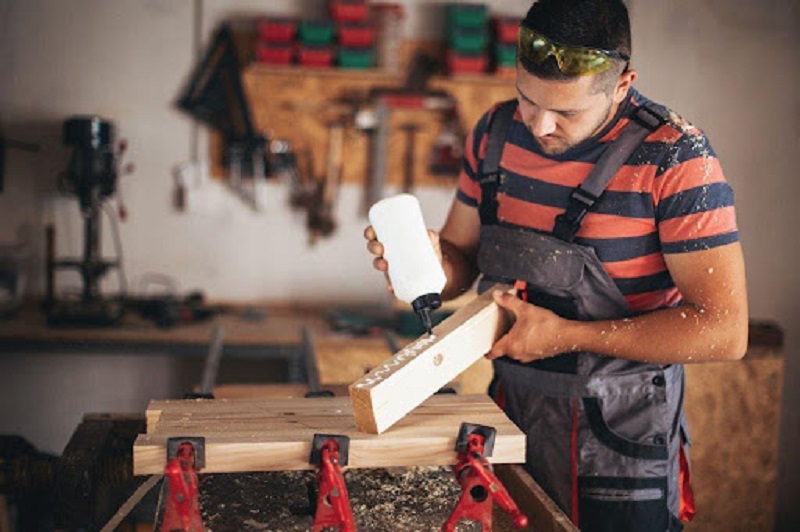We have another awesome guest post to share with you this week, Joinery vs Adhesive: Pros and Cons of each Method. Thank you Kristin Annie for providing this great post for us!! We really enjoyed it and appreciate the time you took!
Today, we’re diving into an intriguing comparison: Joinery vs. Adhesive. This age-old debate centres around the most effective method of connecting or fixing materials, especially in the world of woodworking. On one side, we have joinery, a method steeped in tradition and skill, showcasing the craft of constructing interlocking joints. On the flip side, we have adhesive, a more modern approach, utilising various chemical compounds to bind materials together.
*Note: This post contains affiliate links, so we may earn a small commission when you make a purchase through links on our site at no additional cost to you.
JOINERY VS ADHESIVE:
PROS AND CONS OF EACH METHOD

Both methods hold their ground in terms of practicality, efficiency, and durability. However, each comes with its own set of pros and cons that can influence a craftsman’s choice, depending on the project at hand. Can the precision and artistry involved in joinery hold a candle to the ease and convenience of adhesive? Or does the fast-acting strength of adhesive overshadow the time-honoured skill of joinery?
In this article, we’ll delve into the nitty-gritty of these two methods, shedding light on their strengths and weaknesses. Whether you’re a seasoned woodworker, an aspiring DIY enthusiast, or simply curious about the world of construction and joinery, buckle up for an enlightening exploration. We’re about to dissect the world of Joinery and Adhesive, providing you with the knowledge to make an informed decision for your next project. So, put the kettle on, grab a Tim Tam, and let’s get stuck into this fascinating comparison.
Understanding Joinery and Adhesive
Joinery pertains to the process of connecting two pieces of wood together through a variety of techniques, including but not limited to dovetail joints, mortise and tenon joints, and lap joints. On the other hand, adhesive refers to the use of glue-like substances for bonding wood pieces together. While joinery is often considered a traditional woodworking method, adhesive is seen as a more modern approach.
Advantages of Joinery
Joinery is revered for its durability, strength, and aesthetic appeal. A well-executed joint can withstand heavy loads and extensive use without loosening. Furthermore, joinery offers a cleaner look, enhancing the overall appearance of the finished product. It also eliminates the need for nails or screws, making it a cost-effective solution in the long run.
Disadvantages of Joinery
However, joinery has its downsides too. It requires a high level of skill and precision, making it a time-consuming process. Mistakes in joinery can be costly, both in terms of time and materials. Moreover, certain types of joints may not be suitable for all types of wood or design requirements.
Advantages of Adhesive
Adhesives, on the other hand, are easy to use, requiring little to no expertise. They allow for quick assembly and offer a certain level of flexibility, allowing for minor adjustments during the assembly process. Moreover, adhesives can be used with a variety of materials, not just wood.
Disadvantages of Adhesive
However, adhesive also has its drawbacks. The bond strength largely depends on the quality of the adhesive and the surface preparation. Over time, the bond may weaken, especially under heavy loads or in high-moisture environments. Furthermore, removing adhesive can be challenging, potentially damaging the wood in the process.
Choosing Between Joinery and Adhesive
The decision between joinery and adhesive largely depends on the specific needs of your project. If longevity, strength, and aesthetic appeal are your priorities, joinery might be the best choice. But if you need a quick fix or are working with a variety of materials, adhesive could be the way to go.
Conclusion
In conclusion, both joinery and adhesive have their own set of advantages and disadvantages. The key is to identify the specific needs of your project and choose the method that best aligns with these needs. Regardless of the method you choose, remember that patience, practice, and precision are essential to achieving a high-quality finish in woodworking.
In the ever-evolving world of woodworking, understanding the pros and cons of different methods is crucial. We hope this article has helped shed some light on the joinery vs. adhesive debate, equipping you with the knowledge to make informed decisions in your future woodworking endeavors.
Author Bio: I am Kristin Annie, a qualified blogger. Here you can see my skills which give you small ideas on understanding all the concepts with different themes. I love to write a blog on different topics, like a Health, Fitness, Home Improvement, Kitchen, Furniture, Gardening, Automotive, etc.
Take a look at these other great articles by Kristin Annie below.
The Benefits of Hiring Family Lawyers for Estate Planning and Probate Matters
WRITE GUEST POSTS FOR US
Living 4 You Boutique is looking for bloggers who would like to write free guest posts!! We are accepting submissions in the following categories:
- Recipes
- Travel
- Dieting
- Health
- Exercise
- Saving Money
- DIY Tutorials on Projects or Crafts
- Organizing Tips
- Relationship/Love
If you are interested in having your article published on our site, click here to see how to get started!! We would love to hear from you!!